At Her International, we embrace all humans regardless of age, race, sexual orientation or gender expression. Our mission is to provide educational opportunities for those that are marginalized as women or in the feminine expression and we continue to develop our programs to suit their unique needs. If and when it’s necessary we actively connect and collaborate with other organizations who can provide services for other’s needs.
By focusing on women and girls, Her International empowers families to become sustainable and self-sufficient. This has an indirect, yet powerful, impact on other members of the family including men and boys. When we all recognize and validate the power of our youth and our girls, we will be one step closer to equality.
Globally, girls encounter barriers that prevent them from embracing their potential and evolving into leaders. These barriers include: limited opportunities for education, period poverty, and gender-based violence.
Girls with access to education and safe spaces to learn have the tools and power to chart the course of their future. They become leaders in their family, community, and workplace. They become empowered.
Laws
In 155 countries they have different laws for men than they do for women
112 countries do not criminalize marital rape
49 countries have no specific laws against domestic violence
45 countries have no sexual harassment laws
Education
130 million girls are not in school
66% of the world’s illiterate population are female
Health Care
“At least 250,000 maternal deaths and as many as 1.7 million newborn deaths would be averted if the need for both family planning and maternal and newborn health services were met.”
Child marriage
23 girls become child brides every 2 seconds
Violence and trafficking
71% of victims of human trafficking are female
5000 women murdered in honor killings happen each year
35% of women have experienced sexual or physical violence
Unequal voice and participation
Fewer women in government
Globally, only 24% of parliament seats are by women
There are only 20 female heads of state, that is only 6.3% of global leaders are women (there are 195 countries worldwide)
Unequal labour
In 2013 72.2% men were employed : 47% women
Women get paid less. Globally women take home only 60-75% of men’s wages
Women are more likely to do unpaid work (caring for children, elderly, and those are who are ill.
Women are more likely to work low-wage and/or vulnerable jobs.
Julie Gascon©
Healthier societies:
For every additional year of education a woman gets after the reproductive age, child mortality decreases by 9.5%
Primary school education for women decreases maternal mortality by 70%
Primary school education for women would save 1.7 million children from stunting from malnutrition
Secondary school education for women would save 12 million children from stunting from malnutrition
Secondary education for women would cut child deaths in half, saving 3 million lives.
Prosperous societies:
Economically empower women results in faster economic growth
Greater household income controlled by women has an immediate and direct benefit for their children
Female education leads to increased economic growth. Roughly 50% of economic growth in OECD countries is due to increased education.
““As a tribute to the legions of women who navigated the path of fighting for justice before us, we ought to imprint in the supreme law of the land, firm principles upholding the rights of women.””










